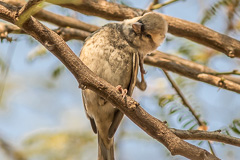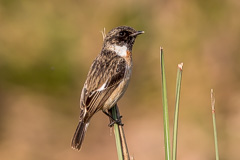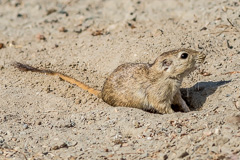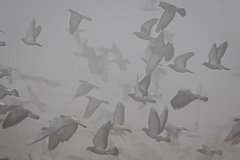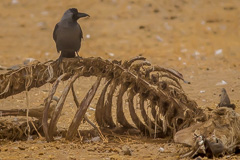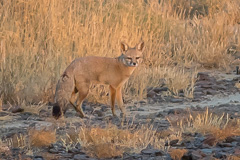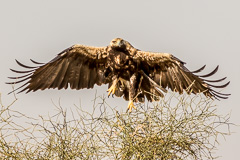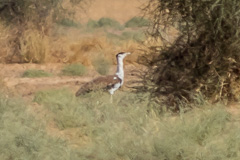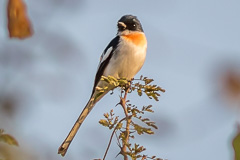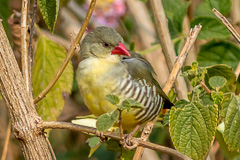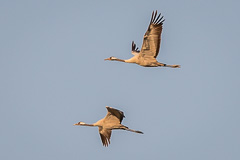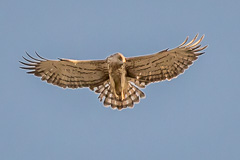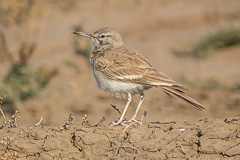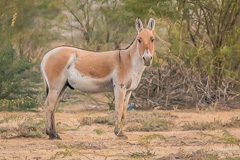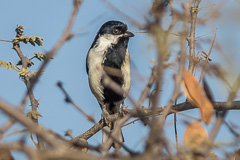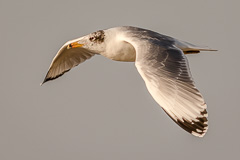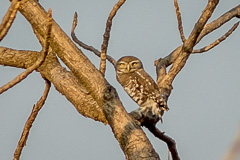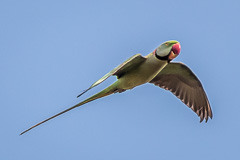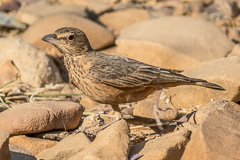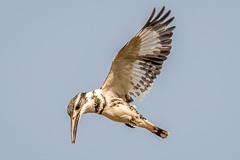Overview
Dates: |
9 - 25 January 2016. |
With Nigel Adlam, Russell Graham, Andrew Herbert, Duncan Himes, Erling Krabbe, Anita Ericson and Lars Petersson. This, a seventh trip to India, fulfilled a long-held desire to target certain rarer specialities, mostly not accessible on previous trips. The key reason for doing western India sooner, rather than later, was to have a reasonable hope of finding Great Indian Bustard, a species undergoing a steep, tragic decline and almost certain to disappear into extinction in the near future. The trip was one of the standard tours offered by BirdTourAsia, led by James Eaton together with Mike Nelson joining to learn the ropes. Food was excellent throughout, especially as we stuck almost exclusively to vegetarian for which this area of India in well known. India seems to have a love-hate relationship with beer and although widely available could often be difficult to obtain. The state of Gujarat is officially dry.
Most sites we visited are well off the tourist beaten track and we encountered relatively few foreigners. The trip worked admirably well, with excellent logistics and all bar a couple of the hoped for species found, though a few gave us a headache. As remaining habitat and protected areas are few and far between in western India, this trip involved much driving and some very early mornings. Several sites required open jeep rides that were bracing to say the least at dawn, as well as being incredibly dusty in the Rann of Kutch - come prepared. In addition to massive loss of habitat throughout, the whole of western India, including inside all reserves and sanctuaries, is overrun with the invasive Mesquite Prosopis juliflora rapidly destroying all native habitats.
A major step forward to visiting India has been the recent introduction of online visas, with single entry tourist visas issued within a few days.
Itinerary
8 Jan. Late afternoon flight from Chiang Mai to Bangkok due to an early departure from Bangkok on 9 Jan necessitating an overnight near the airport.
9 Jan. Up early at stupid o'clock to check in by 05:00 for the Delhi flight. Early morning light rain in Bangkok was a surprise for January. The Thai Airways flight left an hour late, that gave cause for concern with the short connection in Delhi. However, at New Delhi Terminal 3 things worked smoothly so made the connecting Jet Airways flight to Amritsar with 30 minutes to spare, although this plane also then sat one hour on the tarmac waiting for the backlog of delayed flights to be cleared; Delhi being notorious for winter fogs delaying flights.
Ritz Plaza Hotel, Amritsar Not at all what its name would imply, but rather a basic functional hotel, likely one of the better places in town. Old, musty and, like most of India, in need of some maintenance with the rooms smelling of an unhealthy mixture of smoke and curry - welcome to India. The swimming pool was impressive, and likely run as an algae farming business on the side. Good internet speed considering the location, together with excellent food. |
Arrived in Amritsar at 15:00 where met by by local guide, CB, to be transferred though the dust, rubbish and chaos of central Amritsar to the Ritz Plaza Hotel. A few birds en route included Alexandrine Parakeet, Rose-ringed Parakeet, House Crow and Bank Myna. Being a weekend, a huge, noisy pool party was held from 20:00, with our rooms directly above the pool - glad of earplugs but at least the party wound up by midnight. |
10 Jan. A 90 minute drive to Harike Wildlife Sanctuary where we arrived by 07:45. A cool 9°C with heavy fog whilst we undertook breakfast in the field, followed by great weather all day. Early morning spent along the dirt track from the main entrance, finding Rhesus Macaque, White-crowned Penduline Tit, Moustached Warbler, Indian Grey Hornbill, Long-tailed Minivet, Yellow-footed Green Pigeon, White-tailed Stonechat plus brief views of a disappearing Jerdon's Babbler. A number of Rufous-vented Grass Babbler were vocal but took some time to obtain views of. An area of Eucalyptus across from the entrance held many Common Chiffchaff of the Siberian race tristis, with a few Mountain Chiffchaff mixed in. Another stop mid-morning produced the highly hoped for Sind Sparrow. Lunch in the field followed by a drive to the opposite side of the sanctuary where a three hour session produced an impressive collection of wildfowl, Bar-headed Goose, Eurasian Spoonbill, Jerdon's Babbler, White-tailed Stonechat, Steppe Gull, Striated Babbler and Black-breasted Weaver. The return drive, through horrendous Amritsar traffic took almost three hours. 11 Jan. A 06:00 departure, heading again past Harike, where we stopped for breakfast, a short walk and some birding that found a single Moustached Warbler and more Long-tailed Minivet, but little else new. Left the area around 09:15 for the 470 kilometre drive to Tal Chhapar, passing through the oceans of agricultural flatlands that constitute the Punjab. |
As one might imagine 470 kilometres on Indian roads take a lot of time and we finally arrived at Tal Chhapar just after 20:00. A few Indian Gazelle en roue plus Red-naped Ibis. A slight issue with our room booking at the Tal Chhapar Wildlife Sanctuary Guesthouse due to a visiting self-appointed VIP pinching one of our rooms.
12 Jan. As sunrise in western India at this time year comes late, a veritable lie-in till 07:00, followed by a quick coffee and then to the remaining, sparse woodland adjacent to town. Habitat here is unprotected and in a seriously peril condition with few trees remaining, all coppiced, and no understorey due to over-grazing by goats and sheep. Cool early in the day, heating to high twenties by midday - great weather and fantastic light for photography. Our primary target here was Indian Spotted Creeper, found after only an hour's hunt.
Amazing that this bird still clings on here. Other species included Black Redstart, Great Grey Shrike, Indian Robin and Blackbuck, for which the adjacent sanctuary was created. Around 09:00 returned to the guesthouse for breakfast before heading into the sanctuary proper. |
With private vehicles not permitted inside we bundled in two park vehicles and set off across the grasslands. Noticeably few visitors. Although the sanctuary is small, Blackbuck is common and we also had Indian Desert Jird, Eurasian Wild Pig, Indian Hare and Nilgai. A longer walk in the grasslands and scrub gave us Common Crane, Demoiselle Crane, Variable Wheatear, Indian Bush Lark, many Short-toed Lark, Pallid Harrier, Tawny Eagle and Steppe Eagle.
Tal Chhapar Wildlife Sanctuary Guesthouse Although no decent accommodation is available in Tal Chhapar, it is possible to stay at the Wildlife Sanctuary Guesthouse right on the edge of the sanctuary, though there are only have about six rooms. No internet, food basic but good. Rooms spacious and comfortable. Hot water a trickle only. Quiet at night and a pleasant place to stay. |
After lunch and an hour siesta, back into the vehicles for an afternoon session during which we explored scrub and saltpans west of town. This whole area is now overrun with Prosopis juliflora and nothing of original habitat remains. Birds were in short supply but those more interesting included Indian Eagle-Owl, Spotted Owlet, Ruff, Pied Avocet and Common Redshank in the pans. The final hour, pre-dusk, in the grasslands of the sanctuary with several fighting Blackbuck, a good number of Marsh Harrier, Montagu's Harrier and Pallid Harrier, as well a Black-winged Kite, Common Kestrel and Laggar Falcon. |
13 Jan. Finally convinced we were all certifiably mad when up at 03:30 to drive three hours to Bikaner Cattle Dump, where we duly arrived around 07:45. This carcass dump for cows naturally supports hoards of scavenging dogs together with, in winter, visiting eagles. In the thick early fog, the outlines of dogs, vultures, crows and cattle skeletons was positively aerie, and one doesn't want to get downwind of it. In our two hours here we had numerous Steppe Eagle, Eastern Imperial Eagle, Tawny Eagle, Black Kite, Black-eared Kite, Egyptian Vulture, Griffon Vulture and numerous House Crow. The main target was however the wintering Yellow-eyed Pigeon with at least 500 birds present. As the majority of birds here were close and accustomed to people, photographic opportunities would have usually been good. However, as the thick fog refused to lift we left at 10:00 and headed toward Jaisalmer, stopping at Wood Fossil Park outside the city just after 17:00. Although with only had 90 minutes available till dark we spent it productively in a wander over the rocky outcrops and scree, finding Striolated Bunting, Red-tailed Wheatear, Chestnut-bellied Sandgrouse, Desert Lark and Tawny Pipit. Three Emu walking down the road were a major surprise! Completed the drive to Jaisalmer where we overnighted at the Brys Fort Hotel. Amusingly, despite being an international tourist hotel we managed to drink the place dry, as their total stock of beers was only three bottles. Fortunately we'd brought some of our own on the bus! |
Brys Fort Hotel, Jaisalmer The best accommodation of the trip, and one of a massive range of tourist hotels on the outskirts of Jaisalmer. A good, comfortable hotel which looked fairly new, with large rooms, good showers, quiet location and good food. Recommended. The only negative was the appallingly slow Internet, being effectively unusable. |
14 Jan. Left at 06:00, driving past the nicely illuminated Jaisalmer fort en route to Desert National Park, where we bowled-up at 07:30 to immediately start searching for Great Indian Bustard. Without doubt this species was the most sought after of the trip for all concerned. Desert National Park is now, in reality, the only site to find this bird, and the declining numbers mean the possibilities for locating it dwindle year on year. How many birds are present in the area is a total guess, and at the current time the total population is estimated to be no more than 100 - 250 birds maximum. |
A scan from any vantage point in the park immediately shows the scale of the issues faced as the vistas reveal nothing but small settlements, herds of goats, cows and sheep, camels, feral donkeys and dogs - all within the national park. A truly depressing site. A few fenced enclosures protecting the natural grasslands, are designed to help secure the bustard, but with the total protected area being less than 10 square kilometres, that would barely support one breeding pair. Interestingly, most sightings of the bustard are from outside the enclosure areas, where they roam in fields to feed but are frequently disturbed.
It was against this backdrop that we commenced our search at dawn, starting from a slightly raised hill near the ranger's camp. Despite the commanding view, no bustards in the early morning, but an excellent start with a pair of Stoliczka's Bush Chat - another species in steep decline due its need for natural grassland. Additionally we had good numbers of Bimaculated Lark, Short-toed Lark and and Black-crowned Finch-Lark. Around 09:00 we abandoned the early morning viewing and set off on the infamous camel carts, around and within the enclosed area. Camels must surely rank as one of nature's more disgusting creatures, with a seemingly endless repertoire of belching, farting, peeing and slobbering. One particularly rich habit is urinating then swiping it's short flat tail around, spraying urine in all directions - wonderful. So a few hours sitting on a cart directly behind one of these creatures isn't exactly something to look forward to. But, in the interests of bustard hunting, needs must. We started with a circuit of the main enclosure and then a took a track across the middle.
Not a sniff of any bustard, so with the heat of the day commencing we retreated to Oasis India desert camp, where we ran into a group of Belgians who took great delight in telling us they'd seen a bustard that morning as well as the previous evening! After lunch we took a drive/bird along the road running through the park, scanning from any rises. No bustard, but thousands of Bimaculated Lark plus Bengal Fox, Nilgai and Indian Gazelle. In the last 45 minutes of light we viewed from the top of the watch tower near the ranger camp without success. A return to Jaisalmer after 20:00. At least the hotel had restocked the bar. |
15 Jan. Our originally planned itinerary was to depart early to Keechan for the Demoiselle Crane spectacle. However, as we'd failed on our most important bird we returned to Desert National Park for hopefully a successful second attempt. Early morning again scanning from the ranger camp without success, and as no camel carts were yet available, due to the drivers still being in bed, we set off on foot across the conservation area finding a couple more Stoliczka's Bush Chat. Then, with the carts catching us up, back onto the carts with the slobbering camels and all morning spent in a slow meander across the fairly large area. One of our drivers this time round was an older local who really seemed clued-up, and even knew how to scan with binoculars, took us to an area he was convinced held some bustards, but despite a lot of scanning we failed to find any.
Oasis India, Sam One of many desert camps found along the entrance road to Desert National Park. An interesting experience, akin to a Butlin's holiday camp for Indians - campfires, dances and camel rides making up the desert experience. Food good, but noisy till midnight from surrounding camps. Needless to say no Internet. |
After lunch at the same desert camp we returned to the park, again drove the road scanning all afternoon, to finish up at the watch tower. Needless to say a very disappointing day, with us now well behind schedule. Although at this point we'd planned to overnight at Siana, 440 kilometres away, yet another bustard session was called for, so we had opted to overnight at Oasis India. |
16 Jan. Having now put a sizable hole in the itinerary, a final attempt for Great Indian Bustard. Back to the park for dawn where we'd arranged a couple of locals with jeeps to drive around a wider area in search of bustards. Very cold early morning standing on the back of these vehicles, but by they did allow us to explore a wider area outside the conservation area. To maximise our chances by covering a greater area, we set off in different directions, at the real risk of one jeep being totally gripped-off. Given the necessity of a long drive now required to our next site, we'd allowed ourselves till noon as a deadline.
At 11:00 stubborn persistence eventually paid off as two Great Indian Bustard were sited a couple of kilometres from the camp. Fortunately no local people were around and the birds stayed in the area feeding for the next hour, so seen by everyone. |
Talk about success at the eleventh hour, a relief, and a truly impressive bird. As we had no desire to disturb these critically endangered birds we left the area at noon with the birds still feeding. During our morning search we also encountered White-backed Vulture, Laggar Falcon and Eastern Imperial Eagle. A final lunch at the Oasis, followed by a long drive to Siana arriving 21:30. Overnight at Siana Camps and Safaris.
Siana Camps and Safaris, Siana Comfortable accommodation with a distinctly colonial feel, run by a friendly host and his staff. A nice relaxed atmosphere plus good rooms with excellent solar heated showers. The only place where cold beer was produced before even we asked. Looking around the vicinity it's probably also the only realistic place to stay, as very remote with few tourists. No Internet. |
17 Jan. A relative lie-in with breakfast at 06:00 before departing 06:30 to drive to some nearby rocky outcrops and scrub, primarily in search of Rock Bush Quail and Sirkeer Malkoha. Early morning, we found this area rather cool and quiet, with neither of these birds found, though we did have brief views of disappearing Painted Sandgrouse. We next headed a good hour's drive on the other side of town to a well-wooded valley to search for White-bellied Minivet. Despite the good looking a habitat, little seen, so returned to the accommodation for lunch, then pretty much straight out again to the same valley for another attempt. |
More luck this time as a small group of White-bellied Minivet found late in the day. Early evening we visited a water hole with a number of Painted Sandgrouse arriving to drink just after dark. During our day's drive around, despite the obvious poverty, we were impressed with the friendly people and the rich cultural and photographic opportunities for those interested in those aspects. 18 Jan. We left Siana at 04:00 and drove the three and a half hours to Mount Abu. This hill station, heavily visited by local tourists and with at least 100 hotels, is not at all the relaxed natural retreat one might envision. It advertises itself as clean and green with no plastic. Unsurprisingly, we experienced the total opposite, with rubbish and plastic everywhere and open sewers in the local villages. The primary target here was Green Avadavat, an Indian endemic known from only a few localities. However, as the local people continue to clear the scrub for agriculture, finding this bird becomes less straightforward. Following a quick breakfast in the field, we headed out into investigate edges of dry fields around town. Following our frustration with the bustard we were due some luck, and it took barely 20 minutes till we ran into a small group of them. A further couple of hours produced Sulphur-bellied Warbler, Indian Yellow Tit, Yellow-eyed Babbler, Black Redstart and Crested Bunting. |
Left the area at 10:30, heading for the Little Rann of Kutch, arriving around 15:30. We immediately set off across agricultural and waste land toward one of the many pools dotting the region.
As dry season, it was a fair walk of about three kilometers to the lake edge. Stayed till dark finding a good mixture of species such as Pallid Harrier, Bar-headed Goose, Montagu's Harrier, Asian Woolly-necked Stork, Short-toed Snake Eagle, many waterfowl, Eurasian Spoonbill, |
Glossy Ibis, Dalmatian Pelican, Common Crane, Sarus Crane, Greater Spotted Eagle, River Tern, Indian Stone-curlew, Collared Pratincole, Crested Lark and Wire-tailed Swallow. At dusk a few Nilgai wandered toward the lake and several thousand Short-toed Lark flew through. Continued the drive to Desert Coursers for the night. |
Desert Coursers Camp, Surendranagar A simple but comfortable accommodation with a good relaxed feeling. The beds could have done with being a half metre longer. Supposedly has Internet but was not working while we were there. Food fine. |
19 Jan. Another chilly morning as we climbed into an open truck and headed for an hour out across the salt plains. These dry plains are flooded during the monsoon, but at this time are dry and dusty in the extreme.
We started with an hour's search for Asian Houbara, but the cold conditions meant little bird activity so headed further west into the centre of the lake area where we eventually located a single Greater Hoopoe-Lark, our other main target here. |
Returned to our bustard hunt and almost at the time we'd needed to leave came across three Asian Houbara. An extremely shy bird; hardly surprising given the hunting pressure on this species. We also encountered a dozen or more Indian Wild Ass. Back for lunch at Desert Coursers, where we located Pallid Scops Owl and Sykes's Warbler in the garden, before setting off for another five hour drive to Kutch where we arrived after dark.
JP Resort, Kutch A good hotel in a quiet location on edge of town. Internet worked. Food good. Comfortable rooms, though the shower was not up to much. |
20 Jan. Another cool morning but at least on this occasion we had covered SUV vehicles providing protection from the cold, although gaps around the doors meant we were covered in more dust than at the Little Rann of Kutch if that were possible.
|
Started at the well known Hypocolius site at Fulay where we had 13 birds as well as several groups of Rosy Starling. Then a a longer drive around the Banni Grasslands searching for Sociable Lapwing, of which we found two after a couple of hours hunting. Returned to our resort for lunch then out again closer to town, to search for Sykes's Lark which thankfully proved relatively easy to locate.
Lastly we tried an area of good-looking thorn forest - seemingly unlikely to remain given the invasion of plants, people and domestic animals - where we located the stunning White-naped Tit and Marshall's Iora. |
21 Jan. An 04:45 start to drive to Mandvi beach to the south. We arrived pre-dawn so as to spend time hunting the minor roads in the area for Sykes's Nightjar, but despite an hour none was found.
The first half of the morning then spent on the long sandy beach observing a fine collection of species in excellent light and cool weather - Crab-plover, Pallas's Gull, Steppe Gull, Heuglin's Gull, Eurasian Oystercatcher plus Great Knot which is a real rarity here. With the rising heat of the day we turned our attention inland and en route to Kutch scanned numerous fields for Indian Courser. However, only a pair of Cream-coloured Courser found. Back out to the Banni Grasslands, and this time successful in finding Indian Courser along the way. Late afternoon found us at Chhari Lake, which was positively teeming with water birds and an impressive sight. |
Along the lake edge we found Paddyfield Warbler and Indian Reed Warbler, and late in the day thousands of Common Crane flying to roost. After dark we started of Sykes's Nightjar hunt, which turned into quite a runaround, but eventually after two hours searching, we obtained close-up views. Quite a drive to return, and our latest return to date, arriving back at Kutch after 22:00.
Midway Park Hotel Located directly adjacent to the main Mumbai highway at the front and the main train line at the rear, so not a particularly promising place for quiet, though as we were all so exhausted by this stage no one worried about the noise. Rooms very comfortable, reasonable Internet and food good. Given that this is no doubt the best accommodation within easy reach of Tansa, recommended. |
22 Jan. Left 06:00 for the short hour's drive to Bhuj Airport that had pretty tight security. Left on time on Jet Airways 08:30 flight to Mumbai, arriving 09:40. Quite a sight flying into Mumbai as the airport is located pretty much in the city centre surrounded by a contrasting mix of shanty towns and skyscrapers. Met by our local assistant/guide/birders and jumping into three taxis headed 100 kilometres northeast toward Tansa Wildlife Sanctuary. Checked into the Midway Park Hotel right along the highway. |
By far the hottest day of our trip with the temperature touching 35°C, so left 14:45 for the hour drive into the sanctuary in search of Forest Owlet, that has only very recently been discovered in this large area of teak and dipterocarp forest.
Finding the Forest Owlet was a lot easier than expected, as upon reaching the area a bird was calling strongly. A couple of hours in this general area also added Jungle Owlet and Mottled Wood Owl. After dark, a random stop along the, surprisingly busy, road through the sanctuary produced Indian Scops Owl and another Mottled Wood Owl. 23 Jan. A return to the open woodlands of Tansa where we tried birding along the road, where we'd left off last night, assuming that in the early morning it would be quiet. Not a chance. So we soon left the road to try birding various small trails, finding that all eventually led to small settlements. |
Given the very dry conditions not surprisingly it was rather quiet, with a White-naped Woodpecker glimpsed, but several Vigor's Sunbird, our main target. In the afternoon we returned to the Forest Owlet spot, hoping for closer views than yesterday, but the bird still kept its distance. |
A late afternoon walk along a much quieter section of road here produced White-eyed Buzzard, Jungle Prinia and a female Blue-capped Rock Thrush. At dusk we randomly selected an open woodland area, with several Jungle Nightjar active at dusk.
24 Jan. With our last morning, we resumed the quest for White-naped Woodpecker, Indian Scimitar Babbler and Indian Nuthatch, but forest still very quiet. Returned to the accommodation, checked-out and were back on the road to Mumbai by 13:00. Halfway back turned off the highway and cut across Kalyan city. Wow, what a spectacle of chaotic, congested driving, even more so than Amritsar. Mid afternoon we then birded a wasteland cum quarry area near Thane, where despite the dirt, excrement and heat we eventually found a single Streak-throated Swallow, Jungle Bush Quail and Pied Kingfisher. |
Suno Hotel, Mumbai A good quality hotel five minutes from the airport. Everything worked smoothly though Internet speed was a bit suspect. We'd originally planned to have our post-trip dinner at the restaurant here, but surprisingly this tourist hotel lacks of a liquor licence. |
An overnight at the Suno Hotel near the airport. Driving into Mumbai was pleasantly smooth due to today being a Sunday. Final trip dinner at the nearby Oriental Asta restaurant during which Great Indian Bustard was voted Bird of the Trip - unsurprisingly given the blood sweat and tears invested in it! |
25 Jan. Early to Mumbai International Airport, where check-in, immigration and security all worked without hitches, then Jet Airways to Bangkok with connection to Chiang Mai. All in all a very successful trip.
Galleries
Bird images from this, and other, birding trips here.

